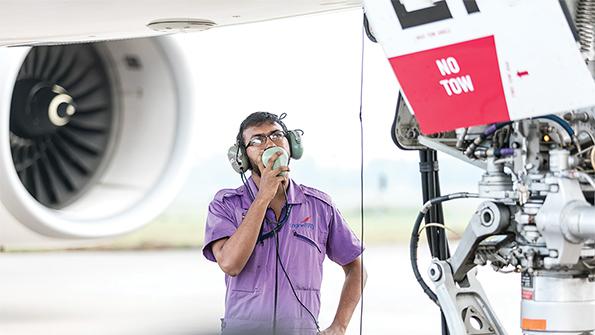
Sri Lankan Airlines
Despite being among the majority of airlines heavily impacted by the cut to passenger numbers during COVID-19, Sri Lankan Airlines is nevertheless looking at new technologies to enhance its business in the long-term. The carrier is exploring the possibility of using big data analytics for predictive maintenance as well as 3D printing, enhanced inspection methods and robotic automation systems. "We are upgrading our [enterprise resource planning (ERP)] system as well. By second-quarter 2022, we will be on a new platform with enhanced capabilities that include mobile device-based paperless operations," Shevantha Weerasekera, head of engineering at Sri Lankan Airlines told Aviation Week.Looking to navigate its long-term future after COVID-19, Shevantha Weerasekera, head of engineering at Sri Lankan Airlines, discusses how the carrier may look to in-source more services while also tapping into the booming passenger-to-freighter conversion market.
What are some of the key elements of Sri Lankan’s maintenance strategy?
As the national carrier of Sri Lanka, SriLankan Airlines has a proud heritage of flying Lockheed Tristar L1011s, Boeing 737s, 767s and 747s and Airbus A340s. Currently, we operate an all-Airbus fleet comprising A320, A321, A330-200 and A330-300 aircraft. To support this varied fleet over the years, significant airframe maintenance, engineering and workshop capability was developed at our main base in Colombo, Sri Lanka.

Today, the engineering arm of Sri-Lankan Airlines can be viewed as an airline-affiliated MRO with over 30 years’ experience, supporting all heavy maintenance requirements for the parent airline as well as a range of third-party customers. Over the past 10 years, we have completed over 300 customer airline C checks, and we also operate three line maintenance stations at Colombo and Mattala in Sri Lanka and Male in the Maldives.
We are working with several partners for engine maintenance, component maintenance and material and logistics support. We have a strong intent to develop airframe maintenance and component maintenance in Sri Lanka and further expand the line maintenance network into both Asia and the Middle East.
What do you look for in an MRO partner, whether this is a maintenance provider or a logistics specialist?
We always strive to find a partner who believes in a mutually beneficial business relationship and who can deliver best value to us, with uncompromising quality. In the recent past, we have opened dialog with all our partners to explore opportunities to develop maintenance capabilities in Sri Lanka, be that via joint ventures to set up a new MRO facility or by using the existing hangars and workshop capacity under a franchise. We see a great opportunity for partners to increase their presence and service offerings in Asia and for SriLankan Engineering to become more active in the MRO space.
Considering the impact of COVID-19 on the global industry, do you foresee more in-sourcing or outsourcing of maintenance at the airline long-term?
During the ongoing pandemic, various countries imposed lockdowns and service providers implemented working-from-home initiatives along with furlough arrangements. This resulted in minor disruptions to our supply chain and delays to our outsourced maintenance activity. Consequently, we will investigate mitigating our risk going forward. SriLankan Engineering has lower labor costs and possesses European Union Aviation Safety Agency (EASA) and national authority approvals from multiple countries. Combined with the savings on logistics, there are clear advantages in in-sourcing. We are looking at new capabilities that we can justify based on the demand from our parent airline as well as external customers.
What has been your experience of recruiting skilled engineers for the airline’s maintenance division?
Sri Lanka has one of the highest literacy rates in Asia and a very sound education system. There is also a lot of interest in aviation as a career choice. We operate our own EASA Part 147 approved training school, which delivers a steady flow of talent to our operations. In fact, the challenge has been accommodating employment opportunities for all the talented and qualified youth who are waiting to join us. We are working on expanding the opportunities that we can offer to these young people through development of new third-party maintenance lines and progressively expanding our capacity. We are also working with the universities and technical colleges to tap into talented graduates for specific roles in engineering, planning, quality assurance and workshops such as composites and aircraft painting.
Did Sri Lankan park most of its aircraft fleet at the height of the crisis? What were the arrangements for this, and what MRO was undertaken to maintain the fleet while grounded?
Like all airlines, SriLankan was impacted by the COVID-19 crisis. We grounded part of our fleet and took steps to preserve these aircraft in line with OEM and regulatory guidelines. We took steps to carry out major maintenance and cabin maintenance while the aircraft were parked. All the maintenance work was undertaken by -SriLankan Engineering, and we were able to execute two C checks for Maldivian as well. During the past six months, we have significantly expanded our cargo operations and have completed an Airbus A330 freighter conversion in-house. We intend to convert a second aircraft and induct dedicated freighters by the third quarter of 2021.
How are you preparing for the increase in maintenance expected to come once flying restrictions are lifted?
As we speak, Sri Lanka’s borders are open for tourists. Thus, SriLankan Airlines has been flying a sustainable network of passenger and cargo traffic. The majority of our fleet is flying, and we conduct periodic maintenance on the few aircraft that remain parked. All the aircraft have completed special service-induction checks, and we have provisioned for critical spares. We have been gearing up for the additional cabin sanitization tasks and added maintenance tasks, such as HEPA (high-efficiency particulate air) filter replacement that will arise with the resumption of services.
Which new technologies are you looking to invest in to enhance your maintenance capabilities?
We are keen to use new technologies to enhance our operational efficiencies. To this end, we are actively looking at the possibility of using big data analytics for predictive maintenance as well as 3D printing, enhanced inspection methods and robotic automation systems. We are upgrading our [enterprise resource planning (ERP)] system as well. By second-quarter 2022, we will be on a new platform with enhanced capabilities that include mobile device-based paperless operations. I am a firm believer in data-driven intelligence, and having a sound IT backbone is very important. SriLankan Engineering has been an early adopter of such IT systems in the region. We are blessed with a competent IT support team with software and app developers in-house. While the ERP system migration is the priority project right now, we have other projects ongoing to capitalize on the capabilities of Office 365 and Power BI. Data analytics and predictive maintenance is the next step, followed by a software solution to manage aircraft technical records.
What are some of your other long-term plans for the airline’s maintenance operation?
As mentioned, we are pushing to expand our line maintenance network. Simultaneously, we are pursuing expansion of our airframe maintenance operation. We are also evaluating the feasibility of opening an additional MRO complex at Mattala Rajapaksa International Airport in the south of Sri Lanka. This will most likely be through a joint venture with one or more OEMs or an established MRO looking to expand capacity in Asia.
SRILANKAN AIRLINES FACT FILE
History: The airline was launched in 1979 as Air Lanka following the termination of operations of the original Sri Lankan flag carrier, Air Ceylon. In 1998, it was partially acquired by Emirates Airline before the government of Sri Lanka acquired all shares 10 years later in 2008.
Fleet: SriLankan operates an all-Airbus fleet comprised of A320- family and A330-family aircraft.
MRO Partners: CFM International, Rolls-Royce, Honeywell and Lufthansa Technik.
In-House Capabilities: SriLankan has the capability to conduct heavy maintenance on the Airbus A320ceos and Neos, Airbus A330ceo family and Airbus A340-200/300 aircraft up to 12-year/8C checks, including cabin modifications, connectivity installation and temporary cargo conversions. Component maintenance capabilities for these aircraft types include avionics, structures, hydromechanical and wheels and brakes services.
In-source to outsource ratio: Weerasekera says approximately 60% of SriLankan’s maintenance is outsourced—including for engines, landing gear and APU services.
Hangars: The airline currently operates two hangars with three lines of maintenance totaling more than 108,000 ft.2 of capacity.



